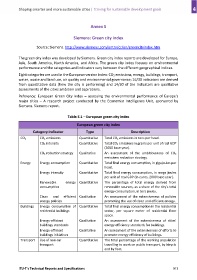Page 923 - Shaping smarter and more sustainable cities - Striving for sustainable development goals
P. 923
Annex S
Siemens: Green city index
Source: Siemens. http://www.siemens.com/entry/cc/en/greencityindex.htm
The green city index was developed by Siemens. Green city index reports are developed for Europe,
Asia, South America, North America, and Africa. The green city index focuses on environmental
performance and the categories and indicators vary between the different geographical indices.
Eight categories are used in the European version index: CO2 emissions, energy, buildings, transport,
water, waste and land use, air quality and environmental governance; 16/30 indicators are derived
from quantitative data (how the city is performing) and 14/30 of the indicators are qualitative
assessments of the cities ambition and aspirations.
Reference: European Green City index – assessing the environmental performance of Europe's
major cities – A research project conducted by the Economist Intelligence Unit, sponsored by
Siemens. Siemens report.
Table S.1 – European green city index
European green city index
Category indicator Type Description
CO2 CO2 emissions Quantitative Total CO2 emissions in tons per head.
CO2 intensity Quantitative Total CO2 emissions in grams per unit of real GDP
(2000 base year).
CO2 reduction strategy Qualitative An assessment of the ambitiousness of CO2
emissions reduction strategy.
Energy Energy consumption Quantitative Total final energy consumption, in gigajoules per
head.
Energy intensity Quantitative Total final energy consumption, in mega joules
per unit of real GDP (in euros, 2000 base year).
Renewable energy Quantitative The percentage of total energy derived from
consumption renewable sources, as a share of the city's total
energy consumption, in tera joules.
Clean and efficient Qualitative An assessment of the extensiveness of policies
energy policies promoting the use of clean and efficient energy.
Buildings Energy consumption of Quantitative Total final energy consumption in the residential
residential buildings sector, per square meter of residential floor
space.
Energy‐efficient Qualitative An assessment of the extensiveness of cities'
buildings standards energy efficiency standards for buildings.
Energy‐efficient Qualitative An assessment of the extensiveness of efforts to
buildings initiatives promote energy efficiency of buildings.
Transport Use of non‐car Quantitative The total percentage of the working population
transport travelling to work on public transport, by bicycle
and by foot.
ITU‐T's Technical Reports and Specifications 913

